Odisha State Board CHSE Odisha Class 11 Biology Solutions Chapter 8 Cell: Structure and Function Textbook Questions and Answers.
CHSE Odisha 11th Class Biology Chapter 8 Question Answer Cell: Structure and Function
Cell: Structure and Function Class 11 Questions and Answers CHSE Odisha
Very Short Answer Type Questions
Multiple choice questions
Question 1.
Which one of the following organelles is without membrane envelop?
(a) Golgi complex
(b) ribosome
(c) peroxisome
(d) tonoplast
Answer:
(b) ribosome
Question 2.
The figures of cork cells as seen by Robert Hooke were published in his book.
(a) origin of species
(b) plant kingdom
(c) genera plantarum
(d) micrographia
Answer:
(d) micrographia
Question 3.
Prokaryotic cell is that which has
(a) primitive nucleus
(b) true nucleus
(c) two nuclei
(d) four nuclei
Answer:
(a) primitive nucleus
Question 4.
Which of the following cells does not contain a nucleus?
(a) yeast
(b) nerve cells
(c) mature WBC
(d) mature RBC
Answer:
(d) mature RBC
Question 5.
Protein and RNA are the principal constituents of
(a) ribosome
(b) chromosome
(c) endoplasmic reticulum
(d) peroxisome
Answer:
(a) ribosome
Question 6.
70s ribosomes are found in
(a) mitochondria and bacteria
(b) mycoplasma and eukaryotic cell
(c) RBC and WBC
(d) epidermal cells and hepatic cells
Answer:
(a) mitochondria and bacteria
Question 7.
Which of the following cell organelles is bound by a single unit membrane?
(a) Golgi apparatus
(b) chloroplast
(c) mitochondrion
(d) lysosome
Answer:
(d) lysosome
Question 8.
Which of the following is the site of steroid synthesis
(a) rough endoplasmic reticulum
(b) ribosomes
(c) smooth endoplasmic reticulum
(d) mitochondrion
Answer:
(c) smooth endoplasmic reticulum
Question 9.
The physical basis of life is
(a) nucleus
(b) protoplasm
(c) cell
(d) food
Answer:
(b) protoplasm
Question 10.
Every living cell possesses
(a) chloroplast
(b) cell membrane
(c) cell wall
(d) food vacuole
Answer:
(b) cell membrane
Question 11.
The chemical substance most abundantly present in the middle lamella is
(a) lignin
(b) suberin
(c) chittn
(d) pectin
Answer:
(d) pectin
Question 12.
The latest model proposed to explain the structure of plasma membrane is
(a) molecular model
(b) sandwich model
(c) unit membrane model
(d) fluid-mosaic model
Answer:
(d) fluid-mosaic model
Question 13.
The peripheral proteins can be easily removed from the membrane by
(a) the action of detergent
(b) solutions of high ionic strength
(c) keeping them in buffer
(d) enzyme action
Answer:
(b) solutions of high ionic strength
Question 14.
Tonoplast is a differentially permeable membrane sorrounding
(a) cytoplasm
(b) mitochondrion
(c) vacuole
(d) nucleus
Answer:
(c) vacuole
Question 15.
F1 -particles are present in
(a) chloroplast
(b) mitochondrion
(c) dictyosome
(d) nucleus
Answer:
(b) mitochondrion
Question 16.
Double membrane is absent in
(a) nucleus
(b) chloroplast
(c) mitochondrion
(d) lysosome
Answer:
(d) lysosome
Question 17.
Polyribosomes are aggregation of
(a) ribosomes on r RNA
(b) Only r RNA
(c) peroxisomes
(d) ribosomes on m RNA
Answer:
(d) ribosomes on m RNA
Question 18.
Ribosomes are attached to ER through
(a) ribophorins
(b) r RNA
(c) t RNA
(d) hydrostatic force
Answer:
(a) ribophorins
Question 19.
The cytoplasmic ribonucleoprotein that binds to free ribosomes so that protein synthesis stops till ribosomes get associated with ER is known as
(a) SPR
(b) SRP
(c) PRS
(d) PSR
Answer:
(b) SRP
Question 20.
Lysosomes are called “suicidal bag” because they have
(a) hydrolytic enzymes
(b) parasitic activity
(c) anabolic enzymes
(d) oxidizing enzymes
Answer:
(a) hydrolytic enzymes
Question 21.
In plant cells the vacuole contains
(a) gases
(b) vacuum
(c) dissolved minerals
(d) only water
Answer:
(c) dissolved minerals
Question 22.
ATP, the energy currency of cell, is synthesised mostly in
(a) ribosomes
(b) mitochondria
(c) lysosomes
(d) nucleus
Answer:
(b) mitochondria
Question 23.
Ribosomes are made up of
(a) RNA and DNA
(b) DNA and proteins
(c) RNA and proteins
(d) RNA alone
Answer:
(c) RNA and proteins
Question 24.
When green tomatoes turn red
(a) chromoplasts change to chloroplasts
(b) chloroplasts change to chromoplasts
(c) new chromoplasts are synthesised
(d) new chloroplasts are synthesised
Answer:
(b) chloroplasts change to chromoplasts
Question 25.
Thylakoids are seen in the plastids of
(a) higher plants
(b) bacteria
(c) algae
(d) blue-green algae
Answer:
(a) higher plants
Question 26.
Foldings of inner mitochondrial membrane are called
(a) cristae
(b) grana
(c) sacs
(d) dictyosomes
Answer:
(a) cristae
Question 27.
Ribosomes of prokaryotes are of
(a) 30s type
(b) 50s type
(c) 70s type
(d) 80s type
Answer:
(c) 70s type
Question 28.
If the ribosomes of a cell are destroyed or blocked, then
(a) respiration will stop
(b) digestion will stop
(c) reproduction will stop
(d) protein synthesis will stop
Answer:
(d) protein synthesis will stop
Question 29.
Site of formation of immature ribosomal sub-units in eukaryotic cell is
(a) cytoplasm
(b) nucleus
(c) nucleolus
(d) nuclear pore complex
Answer:
(c) nucleolus
Question 30.
The main function of Golgi complex is
(a) translocation
(b) fermentation
(c) protein glycosylation
(d) phosphorylation
Answer:
(a) translocation
Question 31.
Peroxisomes contain
(a) transferase enzymes
(b) hydrolytic enzymes
(c) isomerase enzymes
(d) oxidizing enzymes
Answer:
(d) oxidizing enzymes
Question 32.
Nucleoli are rich in
(a) DNA and RNA
(b) DNA, RNA and proteins
(c) DNA
(d) RNA
Answer:
(b) DNA, RNA and proteins
Question 33.
Nucleus was first discovered by
(a) Leewenhoek
(b) Schwann
(c) Robert Brown
(d) Robert Koch
Answer:
(c) Robert Brown
Question 34.
Microtubules are made up of
(a) myosin
(b) actin
(c) tubulin
(d) globulin
Answer:
(c) tubulin
Question 35.
Centromere is a part of
(a) ribosome
(b) chromosome
(c) spherosome
(d) glyoxisome
Answer:
(b) chromosome
Question 36.
Chromosomes with equal arms are called
(a) submetacentric
(b) polycentric
(c) acentric
(d) metacentric
Answer:
(d) metacentric
Question 37.
The hydrophobic chemicals like pesticides and carcinogens are detoxified by enzymes found in
(a) mitochondrion
(b) lysosome
(c) Golgi
(d) SER
Answer:
(b) lysosome
Question 38.
Which of the followings is a prokaryote?
(a) Agaricus
(b) Salmonella
(c) Volvox
(d) Saccharomyces
Answer:
(b) Salmonella
Fill in the blanks
Question 1.
…………. is the cytoplasmic organelle, responsible for cellular respiration.
Answer:
Mitochondria
Question 2.
…………. proposed the unit membrane concept.
Answer:
J. David Robertson
Question 3
…………. is the largest cytoplasmic organelle in plant cell.
Answer:
Plastid
Question 4.
…………. is the smallest cytoplasmic organelle.
Answer:
Ribosome
Question 5.
…………. is a vesicle containing digestive enzymes found in a cell.
Answer:
Lysosome
Question 6.
Intracellular digestion is associated with …………. .
Answer:
Lysosomes
Question 7
…………. maintains the cytoplasmic continuity between neighboring cells.
Answer:
Plasmodesmata
Question 8.
Singer and Nicholson proposed the …………. model for plasma membrane.
Answer:
Fluid-mosaic
Question 9.
Presence of DNA in chloroplasf and mitochondria make them …………. .
Answer:
Semi-autonomous
Question 10.
Colored plastids found in flowering plants are known as …………. .
Answer:
Chromoplast
Question 11.
A chromosome lacking a centromere is …………. .
Answer:
Acentric
Question 12.
Prokaryotic cells contain …………. ribosomes.
Answer:
70S
Question 13.
Histone proteins are …………. by nature.
Answer:
Basic
Question 14.
The portion of DNA between two repeating units of nucleosomes is known as …………. DNA.
Answer:
Linker
Question 15.
When two solutes move across the cell membrane in opposite directions the transport is known as …………. .
Answer:
Antiport
Short Answer Types Questions
Write notes on
Question 1.
Cell wall
Answer:
Cell wall: It is a rigid or semi-rigid envelope lying outside the cell membrane of plants, fungi, etc. It helps in maintaining shape and protecting them from osmotic lysis. It possess three structural components namely middle lamella, primary wall and secondary wall.
Question 2.
Mitochondrion
Answer:
Mitochondrion : These are membrane bound cell organelles, essential for aerobic respiration of eukaryotic cells. These are also known as powerhouse of the cell because, they produces cellular energy in the form of ATP.
Question 3.
Plastids
Answer:
Plastids : These are semi-autonomous organelles that have double membrane envelope. Plastids have their own genetic material (i.e., DNA). Due to their large size, they are easily seen under the microscope. The term plastid was coined by E Haeckel in 1866.
Question 4.
Ribosome
Answer:
Ribosomes : These are small subspherical granular organelles, not bounded by any membrane. Ribosomes were first observed by George Palade (1953), as the dense particles under the electron microscope. Hence, are also called Palade particles.
Ribosomes are mainly composed of ribonucleoproteins (i.e., RNA + proteins) and are also known as protein factories, as they are primarily involved in the synthesis of proteins or polypeptides.
Question 5.
ER
Answer:
Endoplasmic Reticulum : It is a complicated system of membranous channels and flattened vesicles. It is physically continuous with the outer membrane of the nuclear envelope. It is revealed from the electron microscopic studies of eukaryotic cells that there is a presence of a network or reticulum of tiny tubular structures that are being scattered in the cytoplasm.
Note ER is known to be absent in prokaryotes, but is present in all eukaryotic cells except germinal cells and mature human RBCs.
Question 6.
Golgi complex
Answer:
Golgi complex : Golgi complex or Golgi apparatus is a complex protoplasmic structure made up of many flat, disc-shaped sacs or cisternae (0.5-1.0 pm) in diameter), surrounded by vesicles.
Cisternae of Golgi apparatus are found to be stacked parallel to each other. They vary in number in a cell.
They are often curved like shallow bowls to give Golgi complex a definite polarity.
Question 7.
Lysosome
Answer:
Lysosome : These are membrane bound polymorphic vesicles that are produced by the Golgi apparatus. They are rich in several hydrolytic digestive enzymes (hydrolases-lipases, proteases, carbohydrases, etc). These enzymes are usually active at the acidic pH (less than 7). Therefore, are also called acid hydrolases and are capable of digesting macromolecules from various sources like carbohydrates, lipids and nucleic acids.
Question 8.
Vacuole
Answer:
Vacuole : These are large membranous sac found in the cytoplasm. These store substances that are not essentially useful for the cell (like water, sap, excretory product and other materials). Plant vacuoles contain not only water, sugars and salts, but also contain pigments and toxic molecules and also occupy upto 90% of the volume of the cell.
Question 9.
Flagella
Answer:
Flagella : They are long, whip-like organelle. They are fewer im membrane per cell and found at either end of a cell. They show undulatory motion. They are found in prokaryotic bacteria.
Question 10.
Nuclear pore
Answer:
Nuclear pore : Nuclear pores are the openings/pores in the nuclear envelope, formed by the fusion of its two membranes. These pores help in the exchange of materials, especially RNA, proteins, ribosomes, etc., between the cytoplasm and nucleoplasm.
Question 11.
Microtubules
Answer:
Microtubules : They were first observed in nerve cells by De Roberties and Franchi in 1953. They are thin, branched, hollow cylinder of about 20-25 nm diameter.
Each microtubule is composed of 11-13 longitudinal strands of protein protofilaments which encloses a central core. The protofilaments are formed by the polymerisation of a and 1 tubulin powered by the hydrolysis of GTP.
Question 12.
Nucleosome
Answer:
Nucleosome : The DNA in eukaryotic chromosome are very large molecules. Thus, they requires proper packaging of DNA inside the chromoesome in such a way that DNA is compact and functional.
Question 13.
Unit membrane concept
Answer:
- Proposed by j David Robertson in 1959.
- According to it, all biological membranes have the basic unit membrane structure of three layers two outer electron dense layer and one middle electron transparent layer.
- Each dense layer is constituted by protein of 15A thickness and the transparent layer is of bilayer of lipid of 45A thickness.
Long Answer Type Questions
Question 1.
What are chromosomes? Describe their structure and functions.
It has been already studied in the chapter that the nucleus in the interphase has a loose and indistinct network of nucleoprotein fibres called chromatin. However, during different stages of cell division cells show structured chromosomes in place of the nucleus. The chromosomes are meant for the equal distribution of genetic piaterial. Their number is fixed and is same in all individuals of a species. A single human cell has approximately two metre long thread of DNA distributed among its 46 (23 pairs) chromosomes.
Each and every chromosome is composed of a primary constriction or the centromere. On the sides of which the disc-shaped structures known as kinetochores are present
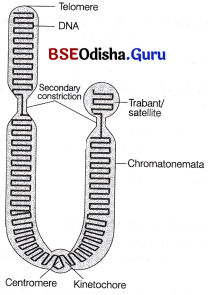
Structure of a typical somatic chromosome during anaphase
Gross Morphology:
On the basis of the position of the centromere, the chromosomes can be classified into following four types
- Metacentric It has chromosome with equal arms and centromere lies in the centre.
- Submetacentric It has one shorter arm and one longer arm with centromere slightly away from the middle of the chromosome.
- Acrocentric It forms one extremely short and one very long arm and centromere is located near the end of the chromosome.
- Telocentric It has the terminal centromere, i.e., placed at an extreme end. Telocentric chromosomes are not present in humans.
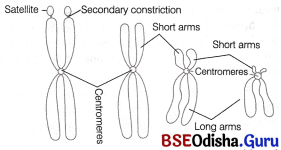
Types of chromosomes based on the position of centromere
Few chromosomes have a non-staining secondary constrictions being present at a constant location at some or the other time which gives the appearance of a small fragment known a satellite.
Chemical Composition:
Chromatin is composed of DNA and some basic proteins called histones. Some non-histone proteins and RNA are also present in the chromatin.
Functions:
Chromosomes performs the following functions
- Control cellular differentiation.
- Contains all hereditary information located in the genes.
- Forms a link between the offspring and the parents.
- Introduce variations, through the process of crossing over.
- Control cell metabolism.
Nucleosome Concept:
The DNA in eukaryotic chromosome are very large molecules. Thus, they requires proper packaging of DNA inside the chromoesome in such a way that DNA is compact and functional.
This is achieved by compacting DNA with the help of histone protein into repeating units called nucleosomes (Roger Kornberg, 1974).
Accroding to this concept five type of histones are found in enkaryotes namely H1, H2A, H2R , H3 and H4.
Two molecules each of H2A, H2B, H3 and H4 together form an octamer called core of nucleosome or Nu-bodies.
A DNA fragment of about 146 base pair wrap around the core 1.75 times and one molecule of H1 associate with it. According to A Klug (Nobble Prize Winner, 1982) this chain of nucleosome is coiled into cylindrical solenoid fibrils of 10 nm having about six nucleosomes per turn. This is further coiled into super solenoid of 30nm (interphase chromatin). During metaphase, it further condense to chromosome.
Question 2.
Explain the fluid-mosaic model of plasma membrane with suitable diagrams.
Answer:
Fluid Mosaic Model
This model was given by Singer and Nicholson (1972). According to this model in a membrane, the lipid bilayer and integral proteins appear like a mosaic arrangement and the quasi-fluid nature of lipid enables the lateral movement of the proteins within the overall bilayer.
This molecular arrangement is stable because it maximisze the contact of hydrophilic regions of proteins and phospholipids with water while providing the hydrophobic parts with a non-aqueous environment.
Freeze fracture technique has provided the most compelling evidence that proteins are embedded in lipids.
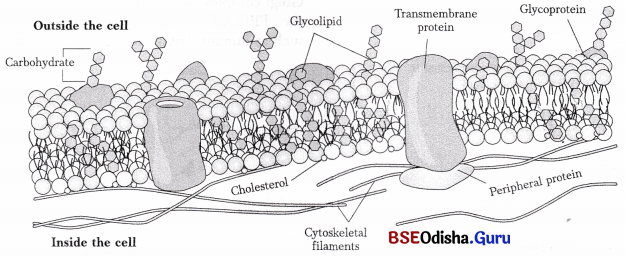
Fluidity of Membrane:
The fluid nature of the membrane is important from the point of view of interactions of molecules within the membrane as well as other functions like formation of intercellular junctions, cell growth, secretion, endocytosis, cell division, etc.
Cell membrane also controls the movement of various substances.
Functions:
Cell membrane performs the following functions
It is a selectively permeable or semipermeable membrane that allows only selected substances to pass through.
It protects the cell from injury.
Membranes have carrier proteins for active transport.
Cell membrane contains enzymes which perform certain reaction on their surface, e.g., ATPase, phosphatase, etc.
Question 3.
What are organelles? Give an account of principal organelles of a cell and mention their functions.
Answer:
A cell which has a well-organised nucleus with a nuclear envelope and several membrane bound organelles is called eukaryotic cell. Internal organisation of eukaryotic cells is more advanced and elaborate, than the prokaryotic cells. Except monerans, eukaryotic organisation is seen in all the protists, plants, fungi and animals. Eukaryotic cell is larger than the prokaryotic cell (i.e., around 10-100 p,m in size).
In eukaryoticcells, an extensive compartmentalisation of cytoplasm is seen through the presence of membrane bound organelles. Eukaryotic cells also possess a variety of locomotory and cytoskeletal structures. All eukaryotic cells are not identical, instead they differ from each other on the basis of structure and function.
Plant Cell and Animal Cell:
Ceil wall is a special membrane, being present in plants, fungi and some protists. Plants cells also contain a large vacuole and plastids, which are absent in animal cells, while animal cells possess centrioles, which are absent in plant cells.
Differences between plant and animal cell
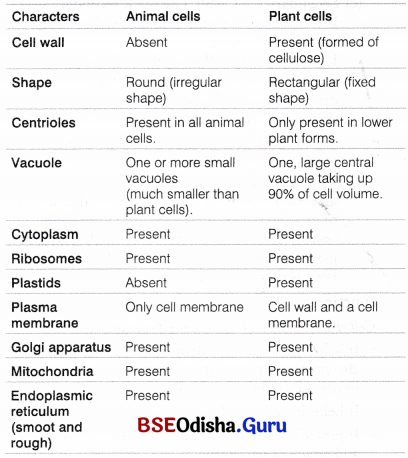
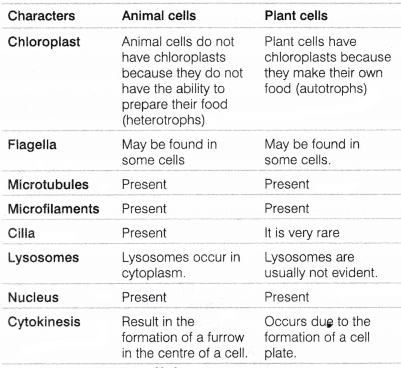
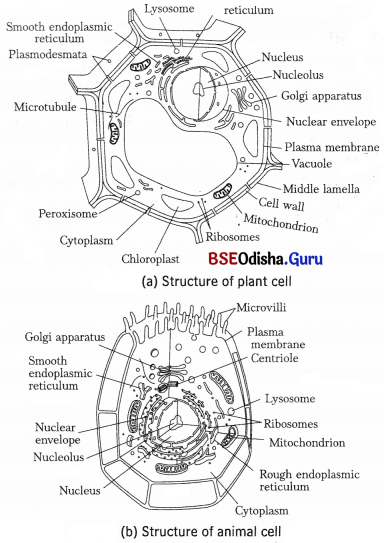
Components of a Eukaryotic Cell:
A eukaryotic cell is composed of various cell components as cell membrane, cell wall (only in plants), mitochondria, chloroplast, Golgi bodies, ribosomes, centrioles (only in animals), etc. All these are described here under in detail.
Cell Wall
It was first discovered by Robert Hooke (1665). It is a rigid and non-living structure which forms an outer covering of the plasma membrane in plants and fungi. It is absent in animal cells.
Components of Cell Wall
(i) Plant cell walls are made up of cellulose which is an unbranched polysaccharide of D-Glucose units linked together by [5-1, 4-glycosidic bond.
(ii) Cell walls of fungi possess chitin while algae have glycoprotein and polysaccharides. A few algae also contain silicic acid and other accessory molecules in cell wall.
Enzymatic and Structural Proteins in Cell Wall
(i) Cell wall contains numerous hydrolases like invertase, glucanases, pectin methyl esterases and phosphatases. Several oxidases are also present in cell wall including ascorbic acid oxidase and laccase involved in lignin formation.
(ii) The most abundant structural proteins are Hydroxyl proline Rich Glycoprotein (HRGP) also called extensin, Arabinogalactan Protein (AGP), Glycine Rich Proteins (GRPS) and Proline Rich Protein (PRP). Except GRPS, the rest are glycoproteins and contain hydroxyl proline.
Extensin connects pectin and hemicelluloses.
Structure of Cell Wall
On the basis of the structure, cell wall is differentiated into three parts namely middle lamella, primary wall and secondary wall.
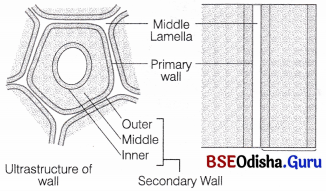
(a) Middle Lamella It is a thin amorphous layer that cement the cell walls of two adjoining cells together. It is the first formed layer and formed during cytokinesis. It is mainly made up of calcium and magnesium pectate.
It is absent on the outer side of cell surface. The pectic substances of this layer are enzymatically converted to partially soluble substances during fruit ripening.
(b) Primary Cell Wall It is produced inner to the middle lamella in a young and growing cell.
It is composed of cellulose, hemicellulose and pectin. The cellulose microfibrils are linked via hemicellulose teethers to form the cellulose-hemicellulose network which is embedded in pectin matrix. Most commonly » occuring hemicelluloses are xylans or xyloglycans.
Mannans and galactans are also found in it. Pectin, the polymer of a-D-galacturonic acid fills the spaces of matrix. The cellulose microfibrils are aligned at all angles and are held together by hydrogen bonds to provide high tensile strength.
(c) Secondary Cell Wall The thick secondary wall is formed inner to the primary wall towards the cell membrane.
Unlike primary cell wall, the cellulose microfibrils are aligned mostly in same direction and with each additional layer the direction of alignment changes slightly. It is strengthened by the deposit of lignin which are polymers of phenyl propane residues.
This wall is laid down by a process called accretion or deposit of material over the surface of existing structure. It is found in trachieds, vessels, fibres and collenchyma, etc. In certain gymnosperms, this layer consist of xylans. This layer is then called tertiary wall.
Functions:
Cell wall performs the following functions
It helps in providing a definite shape to the cell and also protects protoplasm against any mechanical injury, i.e., damage and infection.
- It helps in cell-to-cell interaction.
- It provides barrier to undesirable macromolecules and attack of pathogens.
Cell Wall Growth
The growth of the cell wall takes place in two ways
(i) Intussusceptions It is the growth from within. Area of the cell wall increases in this way. The primary wall is stretched and material of secondary wall are deposited.
(ii) Apposition It is the growth from outside. The thickness of the cell wall increases in this way. Materials of secondary walls are deposited in thin layers.
Functions:
Golgi apparatus performs the following functions
(i) The Golgi apparatus is involved in the formation of lysosomes, vesicles that contain proteins and remains within the cell.
(ii) It performs the function of packaging of material.
(iii) It acts as an important site for the formation of glycoproteins and glycolipids.
(iv) It helps in the production of complex carbohydrates other than glycogen and starch.
(v) It helps in the formation of cell wall.
Lysosomes:
These are membrane bound polymorphic vesicles that are produced by the Golgi apparatus. They are rich in several hydrolytic digestive enzymes (hydrolases-lipases, proteases, carbohydrases, etc). These enzymes are usually active at the acidic pH (less than 7). Therefore, are also called acid hydrolases and are capable of digesting macromolecules from various sources like carbohydrates, lipids and nucleic acids. Two general classes of lysosomes are usually distinguished. These are as follows
(i) Primary Lysosomes Newly formed lysosomes that has not yet encountered the substrate for digestion.
(ii) Secondary Lysosomes (heterophagosomes)
Membranous sacs of diverse morphology and contains substrates and hydrolytic enzymes. They result from repeated fusion of primary lysosomes with membrane bound substrate. They form large digestive vacuoles, multivesicular bodies, autophagosomes, etc.
Functions:
Lysosomes performs the following functions
(i) They digest the food contents (intracellular digestion).
(ii) They also perform extracellular digestion.
(iii) They also digest the old and useless organelles of the cells.
(iv) They also have functioning in cell division.
(v) Principle site of cholesterol assimilation from endocytosed serum lipoprotein.
(vi) Programmed cell death during embryogenesis.
Vacuoles:
These are large membranous sac found in the cytoplasm. These store substances that are not essentially useful for the cell (like water, sap, excretory product and other materials). Plant vacuoles contain not only water, sugars and salts, but also contain pigments and toxic molecules and also occupy upto 90% of the volume of the cell.
The vacuole is bounded by a single membrane structure known as tonoplast which in plant cells, facilitates the transport of materials and some ions against the concentration gradient inside the vacuole. Thus, the concentration of materials tends to be higher in vacuole, than to be in the cytoplasm. Animal cells also have vacuoles, but they are much more prominent in case of plant cells. Thus, plant cells have typically large central vacuoles filled with a watery fluid that gives added support to the cell.
Functions
(i) Storage of reserve food like sucrose, minerals, etc., and secondary metabolites like tannin, latex, etc.
(ii) Impart turgidity to the cell as they contain high solute concentration.
Question 4.
What are the different types of plastids seen in plants? Describe the structure and function of chloroplast
Answer:
Plastids:
These are semi-autonomous organelles that have double membrane envelope. Plastids have their own genetic material (i.e., DNA). Due to their large size, they are easily seen under the microscope. The term plastid was coined by E Haeckel in 1866.
Occurrence
Plastids are found in all plant cells and euglenoides except in some protistans (e.g. Euglena, Dinophyceae, etc).
Types
All plastids are derived from proplastids called eoplasts. Plastids are differentiated into three different types on the basis of the colour, i.e., type of pigments found in them.
(i) Chloroplasts These are the plastids which are greenish in colour containing photosynthetic pigments chlorophyll and carotenoids.
(ii) Chromoplasts These are plastids, which are yellow or reddish in appearance because of the presence of fat soluble carotenoid pigment carotene. Xanthophyll and some other pigments are also present as the fat soluble carotenoid pigment other than carotene, e.g. orange colour of carrot is due to the presence of chromoplasts.
(iii) Leucoplasts These are the colourless plastids of varied shapes and sizes with stored nutrients in the form of carbohydrates, lipids and proteins. These are of following three types
(a) Amyloplasts are the carbohydrates (starch) containing leucoplast, e.g. rice, wheat, potato, etc. Amyloplasts are larger than the normal/original size of leucoplast.
(b) Elaioplasts are the leucoplast which store oils and fats, e.g. tuberose endosperm of castor seeds, etc.
(c) Aleuroplasts (Proteinplast) are the protein storing leucoplasts. e.g. maize (aleurone cells).
Chloroplast:
Schimper (1883) coined the term chloroplast. These are double membrane bound cell organelles that play a major role in photosynthesis.
Occurrence
Chloroplasts occur in major number in the photosynthetic mesophyll cells of leaves and green stem.
Shape and Size
They may be lens-shaped, oval, spherical, discoid or even ribbon-like. They are cup-shaped in Chlorella and Chlamydomonas, girdle-shaped in Ulothrix and spiral in Spirogyra.
They also have variable length (5-10 mm) and width (2-4 mm).
Number:
Their number also varies from 1 per cell in Chlamydomonas (a green alga) to 2-40 per cell in mesophyll cell.
Ultrastructure
Chloroplasts are consists of the two membranes that are smooth and thick (about 90-100 A). The inner membrane of chloroplast is less permeable than the outer one.
The inner membrane is grounded by a space known as stroma or matrix, a dense, colourless and a granular substance mainly formed of soluble proteins. It also contains enzymes which are essential for the synthesis of carbohydrates, lipids and proteins.
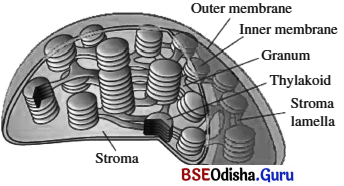
In the stromata, thylakoids are present. These are membranous flattened structures that run throughout the matrix or stroma. Several thylakoids are arranged or organised in stack (like the piles of coins), called grana or the intergranal thylakoids. Many flat membranous tubules that interconnect the thylakoids of different grana are known as stromal lamellae.
Functions:
Chloroplasts perform the following functions
(i) Help in photosynthesis, i.e. formation of organic compounds.
(ii) In consumption of CO<sub>2</sub> and release of O<sub>2</sub> in photosynthesis.
(iii) May also change into chromoplast in order to provide colour to many flowers and fruits.
(iv) Help in storing fat and lipids.
(v) Function in transduction of energy.
Knowledge Plus
• The algal chloroplast are agranal as they lack grana.
• The chloroplast with nitrogen-fixing genes are called nitroplast.
• The space between the two membrane is called intermembrane space, which separates the two membrane. This space contains a narrow fluid. Stroma also contains small, double-stranded circular DNA, molecules and ribosomes.
• Ribosomes of chloroplasts are smaller (70S) than the ribosomes of cytoplasm (80S).
Differentiate between
Question 1.
Cell wall and plasma membrane
Answer:
Differences between cell wall and plasma membrane are
| Cell wall | Plasma membrane |
| Rigid, protective, supportive layer. | Dynamic, quasifluid, film-like layer. |
| Thickness is about 0.1 pm to 10 pm. | Thickness is about 7.5 nm. |
| Consist of cellulose or peptioglycan/chitin, etc. | Consists of lipids proteins, carbohydrates, etc. |
| It is not selectively permeable. | It is selectively permeable. |
Question 2.
Chloroplast and mitochondrion
Answer:
Differences between chloroplast and mitochondrion are
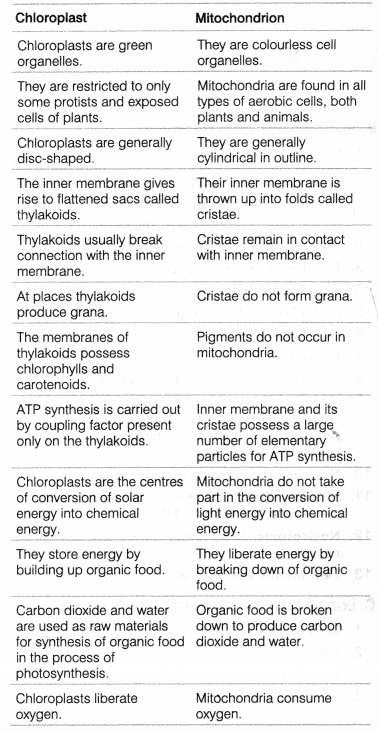
Question 3.
Cytoplasm and karyolymph
Answer:
Differences between cytoplasm karyolymph are
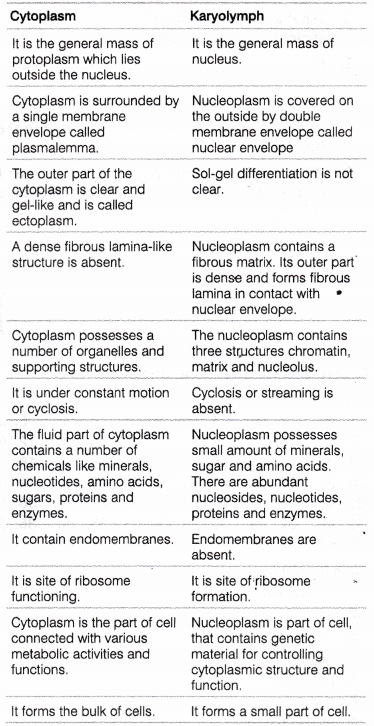
Question 4.
Leucoplast and chloroplast
Answer:
Differences between leucoplast and chloroplast
| Leucoplast | Chloroplast |
| Colourless plastids | Green-coloured plastids. |
| Mainly found in the roots of plants. | Found in leaves of plants. |
| Acts as storehouse of minerals and nutrients. | Take part in photosynthesis. |
| They lack grana and photosynthetic pigments. | Possess grana and photosynthetic pigment |
Question 5.
Chromatin and chromosome
Answer:
Differences between chromatin and chromosome
| Chromatin | Chromosome |
| It is uncondensed part of nucleoprotein complex. | Chromosomes are condensed parts of the nucleoprotein complex. |
| Chromatin is observable in the interphase nucleus. | Chromosomes are observable during M-phase or nuclear division. |
| Chromatin is in the form of fine fibrils that run throughout the nucleus. | Chromosomes are in the form of short thick threads or rods. |
| Replication occurs in the chromatin phase. | It cannot occur in chromosome phase. |
| The replicas are not visible. | Replicas are visible as chromatids. |
| It is active in controlling metabolism and other activities of the cell. | Chromosomes are mainly meant for distribution of genetic information to the daughter cells. |
Question 6.
Nucleus and nucleolus
Answer:
Differences between nucleus and nucleolus
| Nucleus | Nucleolus |
| Large, spherical structure present in the cell. | Small structure, present inside the nucleus. |
| Bounded by nuclear envelope. | It has no limiting membrane. |
| Rich in DNA. | Rich in RNA. |
| Possess chromosomes and cellular membranes. | Possess fibrillar centres, granular component, etc. |
Question 7.
SER and RER
Answer:
Differences between SER and RER
Tablee 8
Question 8.
Intrinsic proteins and peripheral proteins
Answer:
Differences between Intrinsic proteins and peripheral proteins
| Intrinsic Proteins | Peripheral Proteins |
| Embedded in the plasma membrane either partially or completely. | Occur on the surface of plasma membrane. |
| Constitute 70% of total membrane proteins. | Constitute about 30% of total membrane proteins. |
| More hydrophobic. | More hydrophilic. |
| Function as carrier protein, enzymes, transport channels, permeases. | Function as receptors, antigens, recognition centres, etc. |
| e.g., Glycophorins, rhodopsin, etc. | e.g., erythrocyte spectrin, mitochondrial cyt.c, etc. |
Question 9.
Primary cell wall and secondary cell wall
Answer:
Differences between primary cell wall and secondary cell wall
| Primary Cell Wall | Secondary Cell Wall |
| Occur in all plant cells. | Occur in only mature and non-dividing cells. |
| Present inner to middle lamella. | Present inner to primary cell wall. |
| Elastic and thin | Inelastic, rigid and thick. |
| Intussusceptional growth. | Accretional growth. |
| Pits are absent. | Pits are present. |
| Contain less amount of cellulose. | Contain high amount pf ‘ cellulose. |
